Blog & Latest Updates
Fly Fishing Articles
Insects by Common Name


Mayfly Family Heptageniidae (March Browns, Cahills, Quill Gordons)
Taxonomic Navigation -?-
Kingdom
Animalia (Animals)
» Phylum
Arthropoda (Arthropods)
» Class
Insecta (Insects)
» Order
Ephemeroptera (Mayflies)
» Family Heptageniidae (March Browns, Cahills, Quill Gordons)
4 genera aren't included.
Common Name
| Match | Common Name |
| March Browns, Cahills, Quill Gordons |
This is page 15 of specimens of Heptageniidae. Visit the main Heptageniidae page for:
- The behavior and habitat of Heptageniidae.
- 11 underwater pictures of Heptageniidae.
Pictures of 215 Mayfly Specimens in the Family Heptageniidae:
Male Maccaffertium ithaca (Light Cahill) Mayfly Dun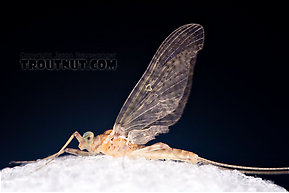 View 6 PicturesBased on the identical size, shape, and relative proportions of different body parts, I'm pretty sure this dun is of the same species as two spinners I collected at about the same time. The color is dramatically different, but that's to be expected with many of these species in the transition from dun to spinner.
View 6 PicturesBased on the identical size, shape, and relative proportions of different body parts, I'm pretty sure this dun is of the same species as two spinners I collected at about the same time. The color is dramatically different, but that's to be expected with many of these species in the transition from dun to spinner.
 View 6 PicturesBased on the identical size, shape, and relative proportions of different body parts, I'm pretty sure this dun is of the same species as two spinners I collected at about the same time. The color is dramatically different, but that's to be expected with many of these species in the transition from dun to spinner.
View 6 PicturesBased on the identical size, shape, and relative proportions of different body parts, I'm pretty sure this dun is of the same species as two spinners I collected at about the same time. The color is dramatically different, but that's to be expected with many of these species in the transition from dun to spinner.Collected June 7, 2007 from the West Branch of the Delaware River in New York
Added to Troutnut.com by Troutnut on June 8, 2007
Added to Troutnut.com by Troutnut on June 8, 2007
Male Cinygmula reticulata (Western Ginger Quill) Mayfly Spinner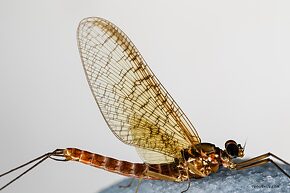 View 7 PicturesThe lengths of the wing and body, measured with a caliper, are both 8 mm.
View 7 PicturesThe lengths of the wing and body, measured with a caliper, are both 8 mm.
Keys in Needham's 1935 Biology of Mayflies point to either Cinygmula reticulata or Cinygmula gartrelli. IT seems to have “cross veins in costal half of fore wing only, slightly margined with brown” and “wings tinged withamber at base and along costal margin of both wings” (gartrelli) as opposed to “all cross veins of both wings faintly but broadly margined with pale smoky” and “wings entirely amber-tinged” (although there is a slight amber tinge throughout, just more pronounced in places) as in reticulata. However, wing length reported for reticulata (9 mm) is closer to this specimen than gartrelli (10 mm). Ventral (Ventral: Toward or on the bottom.) median marks are supposed to be “traces” for reticulata and “present” for gartrelli. Descriptions for both species involve semi-hyaline (Hyaline: Highly transparent, or glassy; usually refers to insect wings, especially those of mayfly spinners.) anterior (Anterior: Toward the front of an organism's body. The phrase "anterior to" means "in front of.") abdominal segments not present on my specimens. Distribution records suggest reticulate lives nearby, so I'm going with that, but I can't confidently rule out gartrelli.
 View 7 PicturesThe lengths of the wing and body, measured with a caliper, are both 8 mm.
View 7 PicturesThe lengths of the wing and body, measured with a caliper, are both 8 mm.Keys in Needham's 1935 Biology of Mayflies point to either Cinygmula reticulata or Cinygmula gartrelli. IT seems to have “cross veins in costal half of fore wing only, slightly margined with brown” and “wings tinged withamber at base and along costal margin of both wings” (gartrelli) as opposed to “all cross veins of both wings faintly but broadly margined with pale smoky” and “wings entirely amber-tinged” (although there is a slight amber tinge throughout, just more pronounced in places) as in reticulata. However, wing length reported for reticulata (9 mm) is closer to this specimen than gartrelli (10 mm). Ventral (Ventral: Toward or on the bottom.) median marks are supposed to be “traces” for reticulata and “present” for gartrelli. Descriptions for both species involve semi-hyaline (Hyaline: Highly transparent, or glassy; usually refers to insect wings, especially those of mayfly spinners.) anterior (Anterior: Toward the front of an organism's body. The phrase "anterior to" means "in front of.") abdominal segments not present on my specimens. Distribution records suggest reticulate lives nearby, so I'm going with that, but I can't confidently rule out gartrelli.
Collected August 1, 2020 from Mystery Creek #237 in Montana
Added to Troutnut.com by Troutnut on August 18, 2020
Added to Troutnut.com by Troutnut on August 18, 2020
Rhithrogena impersonata (Dark Red Quill) Mayfly Nymph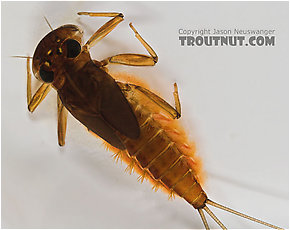 View 8 PicturesThis specimen shows one of two distinct color types of Rhithrogena impersonata nymphs. This type is very reddish, especially in the gills, and it was formerly in its own species called Rhithrogena sanguinea.
View 8 PicturesThis specimen shows one of two distinct color types of Rhithrogena impersonata nymphs. This type is very reddish, especially in the gills, and it was formerly in its own species called Rhithrogena sanguinea.
 View 8 PicturesThis specimen shows one of two distinct color types of Rhithrogena impersonata nymphs. This type is very reddish, especially in the gills, and it was formerly in its own species called Rhithrogena sanguinea.
View 8 PicturesThis specimen shows one of two distinct color types of Rhithrogena impersonata nymphs. This type is very reddish, especially in the gills, and it was formerly in its own species called Rhithrogena sanguinea.Collected June 5, 2005 from the Long Lake Branch of the White River in Wisconsin
Added to Troutnut.com by Troutnut on May 24, 2006
Added to Troutnut.com by Troutnut on May 24, 2006
Female Cinygmula ramaleyi (Small Western Gordon Quill) Mayfly Spinner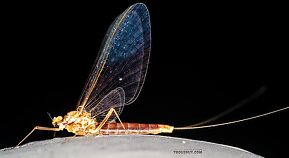 View 8 Pictures
View 8 Pictures
 View 8 Pictures
View 8 PicturesCollected August 3, 2020 from Star Hope Creek in Idaho
Added to Troutnut.com by Troutnut on August 19, 2020
Added to Troutnut.com by Troutnut on August 19, 2020
Heptagenia pulla (Golden Dun) Mayfly Nymph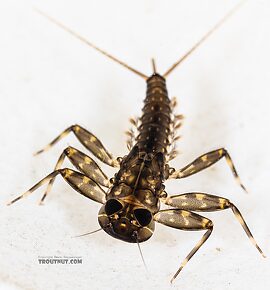 View 11 PicturesThis specimen is interesting because Heptagenia pulla has not been reported from Washington or neighboring states (Saskatchewan is the closest), yet the distinctive key characteristics are clear.
View 11 PicturesThis specimen is interesting because Heptagenia pulla has not been reported from Washington or neighboring states (Saskatchewan is the closest), yet the distinctive key characteristics are clear.
It keys to the genus Heptagenia because the tarsal claw (Tarsal claw: The claws at the tip of the tarsus, on an insect's "foot.") has a single basal (Basal: close to the base; root or beginning) tooth, and the gills on segment 7 have fibrils.
For the species key:
1. The left mandible (Mandible: The paired jaws of an insect which are used for grabbing food, located immediately behind the labrum.) is planate (fairly straight-edged) whereas the right mandible (Mandible: The paired jaws of an insect which are used for grabbing food, located immediately behind the labrum.) is angulate (has one sharp turn on the edge).
2. The labrum (Labrum: The platelike structure forming the roof of the mouth of insects; the upper lip.) is much wider than long.
3. There's a thin light-colored streak lateral (Lateral: To the side.) to the eye on the head.
 View 11 PicturesThis specimen is interesting because Heptagenia pulla has not been reported from Washington or neighboring states (Saskatchewan is the closest), yet the distinctive key characteristics are clear.
View 11 PicturesThis specimen is interesting because Heptagenia pulla has not been reported from Washington or neighboring states (Saskatchewan is the closest), yet the distinctive key characteristics are clear.It keys to the genus Heptagenia because the tarsal claw (Tarsal claw: The claws at the tip of the tarsus, on an insect's "foot.") has a single basal (Basal: close to the base; root or beginning) tooth, and the gills on segment 7 have fibrils.
For the species key:
1. The left mandible (Mandible: The paired jaws of an insect which are used for grabbing food, located immediately behind the labrum.) is planate (fairly straight-edged) whereas the right mandible (Mandible: The paired jaws of an insect which are used for grabbing food, located immediately behind the labrum.) is angulate (has one sharp turn on the edge).
2. The labrum (Labrum: The platelike structure forming the roof of the mouth of insects; the upper lip.) is much wider than long.
3. There's a thin light-colored streak lateral (Lateral: To the side.) to the eye on the head.
Collected April 9, 2021 from the Yakima River in Washington
Added to Troutnut.com by Troutnut on April 12, 2021
Added to Troutnut.com by Troutnut on April 12, 2021
Epeorus deceptivus Mayfly Nymph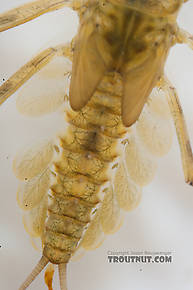 View 8 PicturesGills #1 failing to meet at the center sterna combined with a lack of small dark single spots mid-femur (
View 8 PicturesGills #1 failing to meet at the center sterna combined with a lack of small dark single spots mid-femur (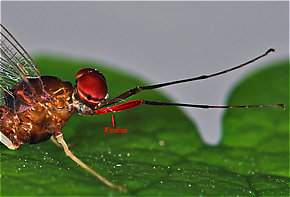 Femur: The main segment of an insect's leg close to the body, in between the tibia and the trochanter.) are characters that differentiate Epeorus deceptivus from Epeorus longimanus.
Femur: The main segment of an insect's leg close to the body, in between the tibia and the trochanter.) are characters that differentiate Epeorus deceptivus from Epeorus longimanus.
 View 8 PicturesGills #1 failing to meet at the center sterna combined with a lack of small dark single spots mid-femur (
View 8 PicturesGills #1 failing to meet at the center sterna combined with a lack of small dark single spots mid-femur (
The femur of this Isonychia bicolor mayfly spinner is highlighted in red.
Collected July 17, 2011 from the Gulkana River in Alaska
Added to Troutnut.com by Troutnut on July 20, 2011
Added to Troutnut.com by Troutnut on July 20, 2011
Cinygmula (Dark Red Quills) Mayfly Nymph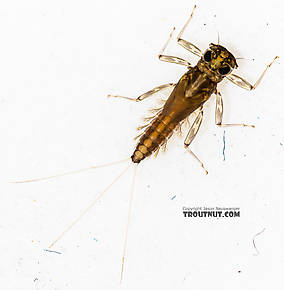 View 8 Pictures
View 8 Pictures
 View 8 Pictures
View 8 PicturesCollected June 13, 2019 from the South Fork Snoqualmie River in Washington
Added to Troutnut.com by Troutnut on June 14, 2019
Added to Troutnut.com by Troutnut on June 14, 2019
Male Cinygmula ramaleyi (Small Western Gordon Quill) Mayfly Dun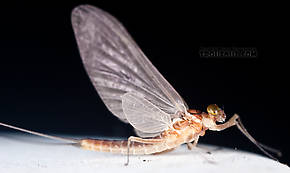 View 8 PicturesThis dun hatched out from a nymph in my aquarium on July 16th, after being collected July 10th. It is probably of the same species as this nymph, and this dun which also hatched from one of these seemingly identical nymphs.
View 8 PicturesThis dun hatched out from a nymph in my aquarium on July 16th, after being collected July 10th. It is probably of the same species as this nymph, and this dun which also hatched from one of these seemingly identical nymphs.
 View 8 PicturesThis dun hatched out from a nymph in my aquarium on July 16th, after being collected July 10th. It is probably of the same species as this nymph, and this dun which also hatched from one of these seemingly identical nymphs.
View 8 PicturesThis dun hatched out from a nymph in my aquarium on July 16th, after being collected July 10th. It is probably of the same species as this nymph, and this dun which also hatched from one of these seemingly identical nymphs.Cinygmula (Dark Red Quills) Mayfly Nymph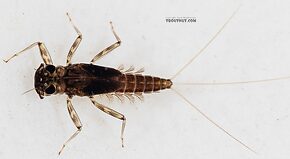 View 7 PicturesUnfortunately there's no good key to species of Cinygmula nymphs and I didn't find an adult, so this one will have to stay at genus level.
View 7 PicturesUnfortunately there's no good key to species of Cinygmula nymphs and I didn't find an adult, so this one will have to stay at genus level.
 View 7 PicturesUnfortunately there's no good key to species of Cinygmula nymphs and I didn't find an adult, so this one will have to stay at genus level.
View 7 PicturesUnfortunately there's no good key to species of Cinygmula nymphs and I didn't find an adult, so this one will have to stay at genus level.Collected July 6, 2020 from Mystery Creek #249 in Washington
Added to Troutnut.com by Troutnut on July 12, 2020
Added to Troutnut.com by Troutnut on July 12, 2020
Male Maccaffertium (March Browns and Cahills) Mayfly Dun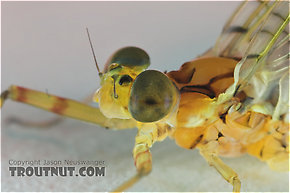 View 6 PicturesI collected this male dun together with a female.
View 6 PicturesI collected this male dun together with a female.
 View 6 PicturesI collected this male dun together with a female.
View 6 PicturesI collected this male dun together with a female.Collected May 27, 2005 from the Namekagon River in Wisconsin
Added to Troutnut.com by Troutnut on May 22, 2006
Added to Troutnut.com by Troutnut on May 22, 2006
Top 10 Fly Hatches
Top Gift Shop Designs
Eat mayflies.
Top Insect Specimens
Miscellaneous Sites
Troutnut.com is copyright © 2004-2024 Jason
Neuswanger (email Jason). See my FAQ for information about use of my images.
 privacy policy
privacy policy
